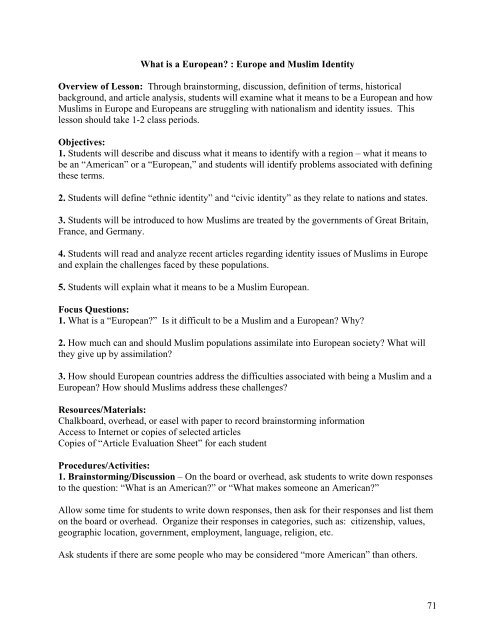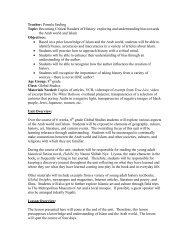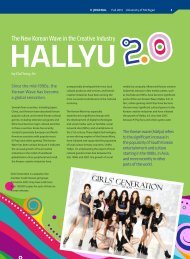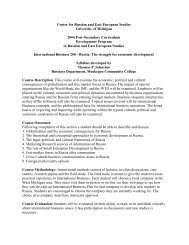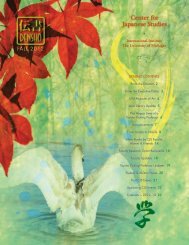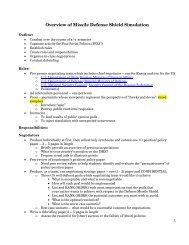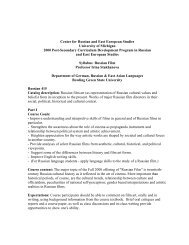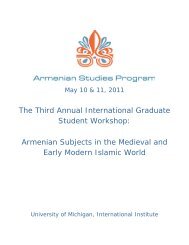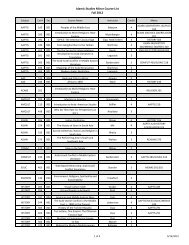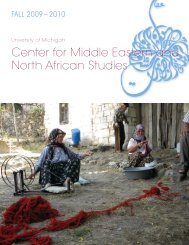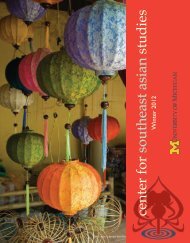Muslims in Europe: - International Institute - University of Michigan
Muslims in Europe: - International Institute - University of Michigan
Muslims in Europe: - International Institute - University of Michigan
Create successful ePaper yourself
Turn your PDF publications into a flip-book with our unique Google optimized e-Paper software.
What is a <strong>Europe</strong>an? : <strong>Europe</strong> and Muslim Identity<br />
Overview <strong>of</strong> Lesson: Through bra<strong>in</strong>storm<strong>in</strong>g, discussion, def<strong>in</strong>ition <strong>of</strong> terms, historical<br />
background, and article analysis, students will exam<strong>in</strong>e what it means to be a <strong>Europe</strong>an and how<br />
<strong>Muslims</strong> <strong>in</strong> <strong>Europe</strong> and <strong>Europe</strong>ans are struggl<strong>in</strong>g with nationalism and identity issues. This<br />
lesson should take 1-2 class periods.<br />
Objectives:<br />
1. Students will describe and discuss what it means to identify with a region – what it means to<br />
be an “American” or a “<strong>Europe</strong>an,” and students will identify problems associated with def<strong>in</strong><strong>in</strong>g<br />
these terms.<br />
2. Students will def<strong>in</strong>e “ethnic identity” and “civic identity” as they relate to nations and states.<br />
3. Students will be <strong>in</strong>troduced to how <strong>Muslims</strong> are treated by the governments <strong>of</strong> Great Brita<strong>in</strong>,<br />
France, and Germany.<br />
4. Students will read and analyze recent articles regard<strong>in</strong>g identity issues <strong>of</strong> <strong>Muslims</strong> <strong>in</strong> <strong>Europe</strong><br />
and expla<strong>in</strong> the challenges faced by these populations.<br />
5. Students will expla<strong>in</strong> what it means to be a Muslim <strong>Europe</strong>an.<br />
Focus Questions:<br />
1. What is a “<strong>Europe</strong>an?” Is it difficult to be a Muslim and a <strong>Europe</strong>an? Why?<br />
2. How much can and should Muslim populations assimilate <strong>in</strong>to <strong>Europe</strong>an society? What will<br />
they give up by assimilation?<br />
3. How should <strong>Europe</strong>an countries address the difficulties associated with be<strong>in</strong>g a Muslim and a<br />
<strong>Europe</strong>an? How should <strong>Muslims</strong> address these challenges?<br />
Resources/Materials:<br />
Chalkboard, overhead, or easel with paper to record bra<strong>in</strong>storm<strong>in</strong>g <strong>in</strong>formation<br />
Access to Internet or copies <strong>of</strong> selected articles<br />
Copies <strong>of</strong> “Article Evaluation Sheet” for each student<br />
Procedures/Activities:<br />
1. Bra<strong>in</strong>storm<strong>in</strong>g/Discussion – On the board or overhead, ask students to write down responses<br />
to the question: “What is an American?” or “What makes someone an American?”<br />
Allow some time for students to write down responses, then ask for their responses and list them<br />
on the board or overhead. Organize their responses <strong>in</strong> categories, such as: citizenship, values,<br />
geographic location, government, employment, language, religion, etc.<br />
Ask students if there are some people who may be considered “more American” than others.<br />
71


